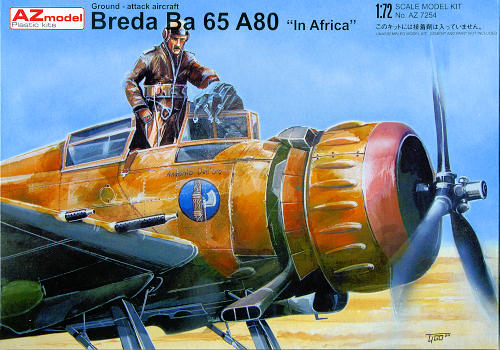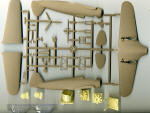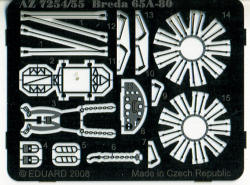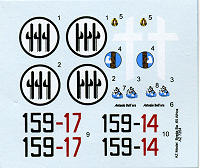
AZ model 1/72 Breda Ba.65 A-80 "In Africa"
| KIT #: | AZ 7354 |
| PRICE: | $26.05 from GreatModels |
| DECALS: | Two options |
| REVIEWER: | Scott Van Aken |
| NOTES: | Short run kit with resin, photo-etch and vacuform parts. |

| HISTORY |
An evolution of Ba.64, the Ba.65 was designed by Antonio Parano and Giuseppe Panzeri. The Ba.65 was a single-seat, all-metal, low-wing cantilever monoplane with aft-retracting main undercarriage. Like its predecessor, it was intended to undertake aeroplano di combattimento multiple roles as a fighter, attack and reconnaissance aircraft. The Ba.65 carried wing-mounted armament of two 12.7 mm (0.5 in) and two 7.7 mm (0.303 in) Breda-SAFAT machine guns, with internal stowage for a 200 kg (440 lb) bombload in addition to external ordnance that could total 1,000 kg (2,200 lb). The prototype, which was first flown in September 1935, like the initial production aircraft, used the 522 kW (700 hp) Gnôme-Rhône K-14 radial engine produced under license by Isotta-Fraschini. Starting from the 82nd aircraft, the more powerful Fiat A.80 RC.41 18-cylinder, twin-row radial with a takeoff rating of 746 kW (1,000 hp) engine was adopted. Production ceased in July 1939 after 218 aircraft were built by Breda and Caproni.
The Ba.65 debuted during the Spanish Civil War. Thirteen Series I aircraft, powered by the Gnôme-Rhône engine, equipped the 65a Squadriglia of the Aviazione Legionaria (Legionary Air Force). The unit took part in operations at Santander in August 1937, then a Teruel and in the battles for the river Ebro. It proved effective and was compared positively with the German Junkers Ju 87 Stuka. In a unique engagement, on 24 July 1936, one of the Legionary Air Force pilots scored an air-to-air victory when he encountered a lone twin-engine Tupolev SB-2 bomber over Soria and shot it down. Of the 23 Ba.65s sent to Spain, 12 had been lost in the course of the civil war. The Ba.65s flew 1,921 sorties, including 368 ground-strafing and 59 dive bombing attacks. When the Aviazione Legionaria returned to Italy in May 1938, they bequeathed their 11 surviving Ba.65s to the Spanish Air Force.
From 2–31 May 1941, the Royal Iraqi Air Force of the Kingdom of Iraq flew the Ba.65 during the Anglo-Iraqi War. War broke out after an Iraqi coup d'état installed a new government while maintaining the existing monarchy. The Ba.65 was used against armed forces of the United Kingdom and the Commonwealth of Nations which were invading the Kingdom to oust the new government.
During World War II, the Ba.65 was employed against the British in North Africa. When Italy entered the war in June 1940 about 150 aircraft were reported to be still in service, albeit suffering heavy losses facing the British fighters. Most were either out of service or shot down by February 1941. The aircraft, which had been forcibly kept in service after the failure of the Ba.88 and the poor performances shown by the Caproni Ca.310, was replaced by modified Savoia-Marchetti S.79s or fighters in the dive bomber role.
A total of 25 Fiat-powered Ba.65s two-seaters were sold to Iraq in 1938. In the mix, were 22 were equipped with Breda L turrets and two dual control trainers. They saw action against the British. Chile bought 20 Ba.65 (17 single-seaters and three dual control trainers) powered by the Piaggio P.XI C.40 (also a 14K derivative), late in the same year. Portugal purchased 10 Breda equipped with Fiat engines and Breda L Turrets, in November 1939. The Soviet Union received 10 aircraft.
| THE KIT |
 Typical
of AZ model's kits, this one is a single sprue with most of the airframe pieces,
several resin parts for the engine and wheels, two vacuformed canopies and a
photo etch fret for detail items. The plastic pieces are very nicely formed and
have a somewhat rough su
Typical
of AZ model's kits, this one is a single sprue with most of the airframe pieces,
several resin parts for the engine and wheels, two vacuformed canopies and a
photo etch fret for detail items. The plastic pieces are very nicely formed and
have a somewhat rough su rface
with crisply engraved panel lines. There are ejector towers on several parts and
a tad bit of flash. The pilot seat back has both a sink mark on the back and a
large ejector tower on the front, requiring some work.
rface
with crisply engraved panel lines. There are ejector towers on several parts and
a tad bit of flash. The pilot seat back has both a sink mark on the back and a
large ejector tower on the front, requiring some work.
Resin is used for the engine cowling, both rows of cylinders, the rather unique exhaust system and the main wheels. Photo etch is used for the harness, engine pushrods, tail plane supports, instrument panel, The lattice work behind the pilot, rudder pedals, and the control surface actuators.
The cockpit is made up of a nicely done cage framework that is inserted into the fuselage halves. Landing gear is quite sturdy with optional mud shields. Some small parts like the pitot tube and small landing gear braces will need to be made from stretched sprue.

 Instructions
are a folded sheet with a brief history, parts layout and 17 well drawn
construction steps. It also contains a generic paint guide. The back of the box
has the camouflage and markings information in full color. Both aircraft
are from the same unit, though at different places during 1940. The box art
plane is in a basically sand background with light mottling in green. The other
is in a light sand with thicker dark green and black mottles. The small decal
sheet is nicely printed.
Instructions
are a folded sheet with a brief history, parts layout and 17 well drawn
construction steps. It also contains a generic paint guide. The back of the box
has the camouflage and markings information in full color. Both aircraft
are from the same unit, though at different places during 1940. The box art
plane is in a basically sand background with light mottling in green. The other
is in a light sand with thicker dark green and black mottles. The small decal
sheet is nicely printed.
| CONCLUSIONS |
Overall, a nice kit that shouldn't give anyone with some short run experience any problems. It should build into a nice representation of a lesser known ground attack type and look very nice on your display shelf.
| REFERENCES |
http://en.wikipedia.org/wiki/Breda_Ba.65
October 2010
You can get this kit and many other fine kits and accessories at www.greatmodels.com .
If you would like your product reviewed fairly and quickly, please contact me or see other details in the Note to Contributors.